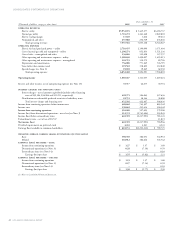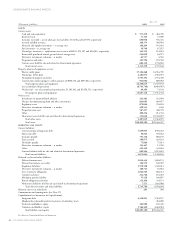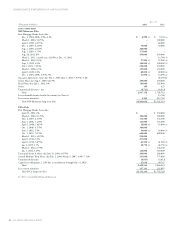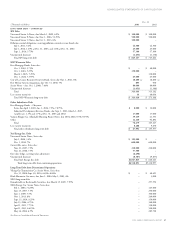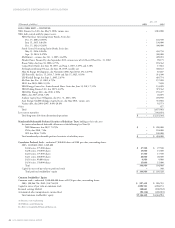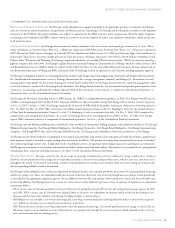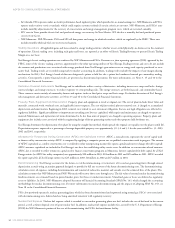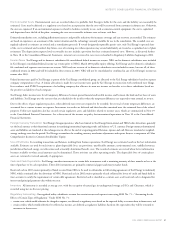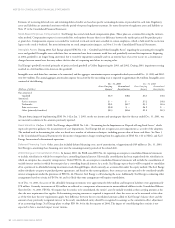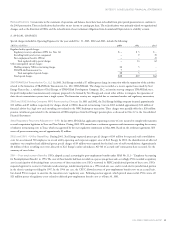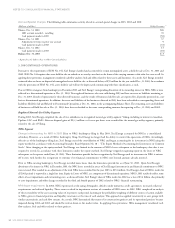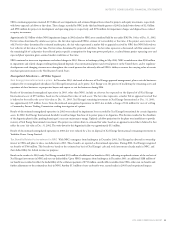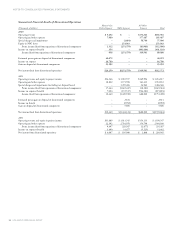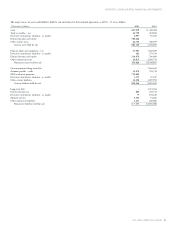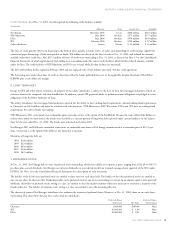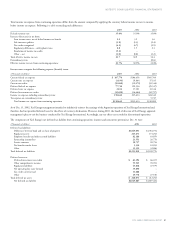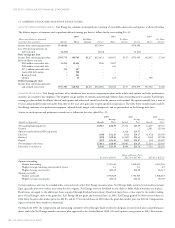Xcel Energy 2003 Annual Report Download - page 36
Download and view the complete annual report
Please find page 36 of the 2003 Xcel Energy annual report below. You can navigate through the pages in the report by either clicking on the pages listed below, or by using the keyword search tool below to find specific information within the annual report.
52 XCEL ENERGY 2003 ANNUAL REPORT
NOTES TO CONSOLIDATED FINANCIAL STATEMENTS
Estimates of recovering deferred costs and returning deferred credits are based on specific ratemaking decisions or precedent for each item. Regulatory
assets and liabilities are amortized consistent with the period of expected regulatory treatment. See more discussion of regulatory assets and liabilities at
Note 19 to the Consolidated Financial Statements.
Stock-Based Employee Compensation Xcel Energy has several stock-based compensation plans. Those plans are accounted for using the intrinsic-
value method. Compensation expense is not recorded for stock options because there is no difference between the market price and the purchase price
at grant date. Compensation expense is recorded for restricted stock and stock units awarded to certain employees, which is held until the restriction
lapses or the stock is forfeited. For more information on stock compensation impacts, see Note 11 to the Consolidated Financial Statements.
Intangible Assets During 2002, Xcel Energy adopted SFAS No. 142 – “Goodwill and Other Intangible Assets” regarding the accounting for intangible
assets and goodwill. Intangible assets with finite lives are amortized over their economic useful lives and periodically reviewed for impairment. Beginning
in 2002, goodwill is no longer being amortized, but is tested for impairment annually and on an interim basis if an event occurs or a circumstance
changes between annual tests that may reduce the fair value of a reporting unit below its carrying value.
Xcel Energy’s goodwill consisted primarily of project-related goodwill at Utility Engineering for 2003 and 2002. During 2003, impairment testing
resulted in a $4.8 million write-down in this goodwill.
Intangible assets with finite lives continue to be amortized, and the aggregate amortization expense recognized in both years ended Dec. 31, 2003 and 2002,
were $0.3 million. The annual aggregate amortization expense for each of the five succeeding years is expected to approximate $0.2 million. Intangible assets
consisted of the following:
Dec. 31, 2003 Dec. 31, 2002
Gross Carrying Accumulated Gross Carrying Accumulated
(Millions of dollars) Amount Amortization Amount Amortization
Not amortized:
Goodwill $3.5 $0.6 $8.3 $0.6
Amortized:
Service contracts $– $– $5.2 $0.8
Trademarks $5.1 $0.7 $5.1 $0.6
Prior service costs $5.8 $ – $6.9 $ –
Other (primarily franchises) $2.3 $0.6 $2.0 $0.5
The pro forma impact of implementing SFAS No. 142 at Jan. 1, 2001, on the net income and earnings per share for the year ended Dec. 31, 2001, was
not material in relation to the amounts previously reported.
Asset Valuation On Jan. 1, 2002, Xcel Energy adopted SFAS No. 144 – “Accounting for the Impairment or Disposal of Long-Lived Assets,” which
supercedes previous guidance for measurement of asset impairments. Xcel Energy did not recognize any asset impairments as a result of the adoption.
The method used in determining fair value was based on a number of valuation techniques, including present value of future cash flows. See Note 3
to the Consolidated Financial Statements for discussion of impairment charges resulting from the application of SFAS No. 144 to NRG’s and Xcel
Energy International’s discontinued operations.
Deferred Financing Costs Other assets also included deferred financing costs, net of amortization, of approximately $49 million at Dec. 31, 2003.
Xcel Energy is amortizing these financing costs over the remaining maturity periods of the related debt.
2004 Changes in Consolidation Policy In January 2003, the FASB issued FIN No. 46, requiring an enterprise’s consolidated financial statements
to include subsidiaries in which the enterprise has a controlling financial interest. Historically, consolidation has been required only for subsidiaries in
which an enterprise has a majority voting interest. Under FIN No. 46, an enterprise’s consolidated financial statements will include the consolidation of
variable-interest entities in which the enterprise has a controlling financial interest. As a result, Xcel Energy expects that it will be required to consolidate
all or a portion of its affordable housing investments made through Eloigne, which currently are accounted for under the equity method. The Xcel Energy
utility subsidiaries are party to purchased power agreements, and based on the current guidance, these contracts are not expected to be considered variable
interest arrangements under the provisions of FIN No. 46. However, Xcel Energy is still evaluating the issue. Additionally, Xcel Energy is evaluating other
arrangements based on criteria in FIN No. 46, and it is likely that some arrangements will require consolidation.
As of Dec. 31, 2003, the assets of the affordable housing investments were approximately $142 million and long-term liabilities were approximately
$78 million. Currently, investments of $56 million are reflected as a component of investments in unconsolidated affiliates in the Consolidated Balance
Sheet for Dec. 31, 2003. FIN No. 46 requires that for entities to be consolidated, the entities’ assets be initially recorded at their carrying amounts at the
date the new requirement first applies. If determining carrying amounts as required is impractical, then the assets are to be measured at fair value
as of the first date the new requirements apply. Any difference between the net consolidated amounts added to Xcel Energy’s balance sheet and the
amount of any previously recognized interest in the newly consolidated entity should be recognized in earnings as the cumulative-effect adjustment
of an accounting change. Xcel Energy plans to adopt FIN No. 46 in the first quarter of 2004. The impact of consolidating these entities is not
expected to have a material impact on net income.


